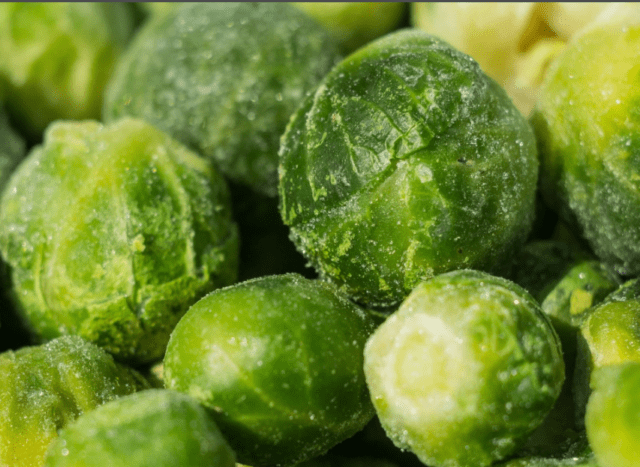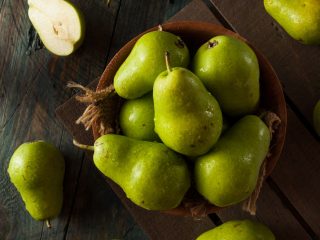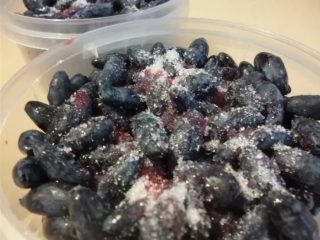Content
Growing a crop of Brussels sprouts is a relatively simple task. But, unlike the “classic” white cabbage, it will not last long when fresh. Therefore, we have to look for alternative ways to preserve heads of cabbage in winter. One of the most popular, which allows you to preserve the beneficial properties and taste to the maximum, is freezing Brussels sprouts.
Can Brussels sprouts be frozen?
Freezing is one of the most universal ways to preserve vegetables, berries and fruits grown in your garden for the winter. This method also works for Brussels sprouts.

If you follow the procedure algorithm, then after freezing more than 90% of the vitamins are preserved
After freezing, Brussels sprouts soften a little and lose their characteristic crunch; if stored for a long time, they change their rich green color to lime. However, the taste does not suffer.
Choosing cabbage for freezing
For freezing, select only Brussels sprouts of a typical size for a given variety - not too large and not small. It should not be loose, lethargic or soft. Color is also important - specimens with yellow leaves are not suitable for freezing.

The “gold standard” for this crop is specimens with a diameter of 2.5-3 cm
Specimens with even minor mechanical damage, traces of insect damage and signs of any diseases are also rejected. This applies not only to the head of cabbage - Brussels sprouts with a broken, cracked stalk are not suitable for freezing. Through such damage, spores of pathogenic fungi and other pathogens quickly penetrate into the tissue.
Preparing cabbage
The cut on the stalk of Brussels sprouts selected for freezing is renewed. It manages to oxidize and turn black under the influence of light and air in just a few hours.

There is no point in leaving long stalks - they are not eaten
When preparing Brussels sprouts for freezing, wash them in cool running water, in small portions, in a colander. To get rid of remaining plant and other debris, insect larvae hiding under the leaves, it is soaked in salt water for 10-15 minutes. The concentration of the solution is 12-15 g/l.

To complete the preparation for freezing, rinse the Brussels sprouts again in clean water.
Blanching
In most cases, Brussels sprouts are blanched before freezing. This technology has significant advantages:
- increasing shelf life up to a year without loss of consumer properties and benefits;
- the ability to use “semi-finished product” without defrosting;
- minimum time spent on heat treatment during the cooking process (8-10 minutes).

Blanching is necessary to destroy enzymes that cause vegetables, fruits and berries to quickly spoil
If you avoid blanching before freezing, the shelf life of the “semi-finished product” in the freezer is reduced to 2-3 months. When it runs out, it doesn’t look very presentable - it turns black, shrivels, and during the heat treatment process turns into an unappetizing porridge. The taste also suffers greatly.
Before cooking, frozen fresh Brussels sprouts need to be boiled. Preparation in this case additionally includes thoroughly drying the washed heads of cabbage.

It is very difficult to preserve the presentability of Brussels sprouts boiled after freezing.
Blanching before freezing goes like this:
- Boil water in a large saucepan (about 3 liters per 1 kg of heads of cabbage). Reduce heat to medium. Brussels sprouts are usually boiled in water acidified with vinegar or lemon juice, but this is not necessary now.
- Place Brussels sprouts in a saucepan of boiling water. It needs to be completely drowned.
- Leave in boiling water for 2-3 minutes. If it is large enough, the heat treatment time increases by another 1-2 minutes. You can’t over-blanch it - it will become soft, lose its shape and lose a significant part of its nutrients. It is convenient to focus on the color of the outer leaves - when it becomes brighter and more saturated, it is time to remove them from the pan.
- Using a slotted spoon, transfer the heads of cabbage to another fairly deep container filled with very cold water and ice cubes.
- After 4-5 minutes, remove the Brussels sprouts from the container and spread them out to dry on paper or linen napkins.There should not be even small drops of water left on it - during the freezing process they will turn into frost and ice crystals.

Cooling is necessary to instantly stop cooking and quickly cool the Brussels sprouts before freezing.

The drying process after blanching will go faster if you lay out the heads of cabbage in one layer so that they do not touch each other
How to freeze Brussels sprouts at home
You can freeze Brussels sprouts either in plastic containers with lids or in reusable ziplock bags. Both can be placed in the freezer quite compactly. The container must be clean, absolutely dry and hermetically sealed.
Heads of cabbage prepared for freezing are laid out on baking sheets, trays, large plates, covered with paper napkins in one layer, “in isolation.” The heads of cabbage should not touch each other, otherwise they will stick together into one lump.
It takes 1.5-2 hours to freeze Brussels sprouts in the freezer. If it has a “fast”, “shock” or “super” freezing mode, the treatment time at negative temperatures is reduced to 10-15 minutes. This technology allows you to preserve nutrients, taste and presentable appearance to the maximum.
Then the Brussels sprouts are removed from the “substrate” and placed in bags or containers. Portions should be relatively small so that they can be completely used in cooking at one time.The heads of cabbage are stacked as tightly as possible, leaving as little air as possible between them.

Air is additionally released from the bags “manually” before closing
After freezing, the “semi-finished product” is also stored in the freezer at a constant temperature of -18 °C. It is recommended to immediately write today’s date on the bags with a permanent marker in order to notice in time that the heads of cabbage are reaching the end of their “expiration date”.

Brussels sprouts that have been stored for too long will cause the outer outer leaves to dry out and become discolored.
Tips and tricks
Brussels sprouts removed from the freezer can be cooked almost immediately - just pour boiling water over them. Some professional chefs refuse even this, throwing it into a hot frying pan or into a pan of boiling water. Long, gradual defrosting at room temperature is not necessary. The exception is heads of cabbage that have been frozen without prior blanching.
Large Brussels sprouts are difficult to pack compactly into bags or containers. To save space in the freezer, dried after blanching or fresh heads of cabbage are cut in half or into quarters before processing at sub-zero temperatures.
The process of blanching before freezing will go much faster if you put the heads of cabbage in a container with boiling water and cold water, after placing them in a colander or sieve. Now you don’t need to catch them out of the pan one at a time, and the risk of keeping the heads of cabbage in boiling water is significantly reduced.
Not only Brussels sprouts, but assorted vegetables look very original. You can add carrots, corn kernels, green peas, chopped bell peppers, green beans, cauliflower or broccoli to bags or containers. The freezing technology for them is similar.

Larger vegetables are cut so that the pieces are comparable in size to heads of cabbage
Brussels sprouts, after freezing for the winter, are used for the same dishes as fresh ones. It can be stewed, boiled, baked, fried. It turns out to be a very tasty and healthy side dish.

Only a professional taster can differentiate between cabbage heads “from the garden” and “semi-finished product” from the freezer based on taste, juiciness and aroma.
Conclusion
Freezing Brussels sprouts for the winter is a method that allows you to store heads of cabbage for up to a year. However, beneficial properties and taste can be preserved only if you take into account some important nuances. They concern the selection and preliminary preparation of heads of cabbage for freezing, and the procedure itself.








